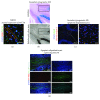Oligodendroglial Lineage Cells in Thyroid Hormone-Deprived Conditions
- PMID: 31182964
- PMCID: PMC6515029
- DOI: 10.1155/2019/5496891
Oligodendroglial Lineage Cells in Thyroid Hormone-Deprived Conditions
Abstract
Oligodendrocytes are supporting glial cells that ensure the metabolism and homeostasis of neurons with specific synaptic axoglial interactions in the central nervous system. These require key myelinating glial trophic signals important for growth and metabolism. Thyroid hormone (TH) is one such trophic signal that regulates oligodendrocyte maturation, myelination, and oligodendroglial synaptic dynamics via either genomic or nongenomic pathways. The intracellular and extracellular transport of TH is facilitated by a specific transmembrane transporter known as the monocarboxylate transporter 8 (MCT8). Dysfunction of the MCT8 due to mutation, inhibition, or downregulation during brain development leads to inherited hypomyelination, which manifests as psychomotor retardation in the X-linked inherited Allan-Herndon-Dudley syndrome (AHDS). In particular, oligodendroglial-specific MCT8 deficiency may restrict the intracellular T3 availability, culminating in deficient metabolic communication between the oligodendrocytes and the neurons they ensheath, potentially promulgating neurodegenerative adult diseases such as multiple sclerosis (MS). Based on the therapeutic effects exhibited by TH in various preclinical studies, particularly related to its remyelinating potential, TH has now entered the initial stages of a clinical trial to test the therapeutic efficacy in relapsing-remitting MS patients (NCT02506751). However, TH analogs, such as DITPA or Triac, may well serve as future therapeutic options to rescue mature oligodendrocytes and/or promote oligodendrocyte precursor cell differentiation in an environment of MCT8 deficiency within the CNS. This review outlines the therapeutic strategies to overcome the differentiation blockade of oligodendrocyte precursors and maintain mature axoglial interactions in TH-deprived conditions.
Figures


Similar articles
-
Monocarboxylate Transporter 8 Deficiency: Delayed or Permanent Hypomyelination?Front Endocrinol (Lausanne). 2020 May 13;11:283. doi: 10.3389/fendo.2020.00283. eCollection 2020. Front Endocrinol (Lausanne). 2020. PMID: 32477268 Free PMC article. Review.
-
Overcoming Monocarboxylate Transporter 8 (MCT8)-Deficiency to Promote Human Oligodendrocyte Differentiation and Myelination.EBioMedicine. 2017 Nov;25:122-135. doi: 10.1016/j.ebiom.2017.10.016. Epub 2017 Oct 19. EBioMedicine. 2017. PMID: 29111262 Free PMC article.
-
Oligodendrocyte progenitor cell maturation is dependent on dual function of MCT8 in the transport of thyroid hormone across brain barriers and the plasma membrane.Glia. 2021 Sep;69(9):2146-2159. doi: 10.1002/glia.24014. Epub 2021 May 6. Glia. 2021. PMID: 33956384
-
Thyroid hormone transporter Mct8/Oatp1c1 deficiency compromises proper oligodendrocyte maturation in the mouse CNS.Neurobiol Dis. 2023 Aug;184:106195. doi: 10.1016/j.nbd.2023.106195. Epub 2023 Jun 10. Neurobiol Dis. 2023. PMID: 37307933
-
Disorder of thyroid hormone transport into the tissues.Best Pract Res Clin Endocrinol Metab. 2017 Mar;31(2):241-253. doi: 10.1016/j.beem.2017.05.001. Epub 2017 May 24. Best Pract Res Clin Endocrinol Metab. 2017. PMID: 28648511 Review.
Cited by
-
Endocrine Therapy for the Functional Recovery of Spinal Cord Injury.Front Neurosci. 2020 Dec 17;14:590570. doi: 10.3389/fnins.2020.590570. eCollection 2020. Front Neurosci. 2020. PMID: 33390881 Free PMC article. Review.
-
FT4-to-FT3 ratio is a novel prognostic marker in subacute combined spinal cord degeneration patients.Transl Neurosci. 2024 May 3;15(1):20220340. doi: 10.1515/tnsci-2022-0340. eCollection 2024 Jan 1. Transl Neurosci. 2024. PMID: 38708097 Free PMC article.
-
Absence of Both Thyroid Hormone Transporters MCT8 and OATP1C1 Impairs Neural Stem Cell Fate in the Adult Mouse Subventricular Zone.Stem Cell Reports. 2021 Feb 9;16(2):337-353. doi: 10.1016/j.stemcr.2020.12.009. Epub 2021 Jan 14. Stem Cell Reports. 2021. PMID: 33450189 Free PMC article.
-
Relationship between thyroid hormones and central nervous system metabolism in physiological and pathological conditions.Pharmacol Rep. 2022 Oct;74(5):847-858. doi: 10.1007/s43440-022-00377-w. Epub 2022 Jun 30. Pharmacol Rep. 2022. PMID: 35771431 Review.
-
Monocarboxylate Transporter 8 Deficiency: Delayed or Permanent Hypomyelination?Front Endocrinol (Lausanne). 2020 May 13;11:283. doi: 10.3389/fendo.2020.00283. eCollection 2020. Front Endocrinol (Lausanne). 2020. PMID: 32477268 Free PMC article. Review.
References
Publication types
LinkOut - more resources
Full Text Sources
Other Literature Sources

